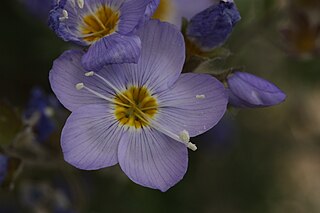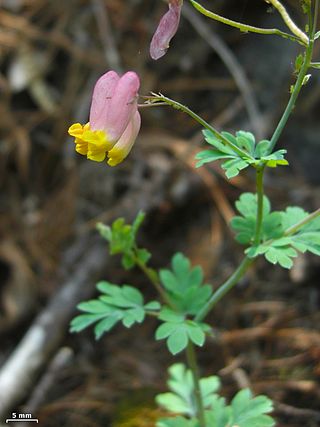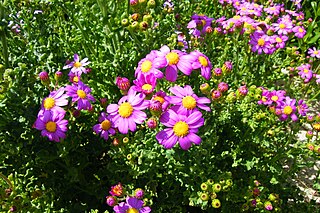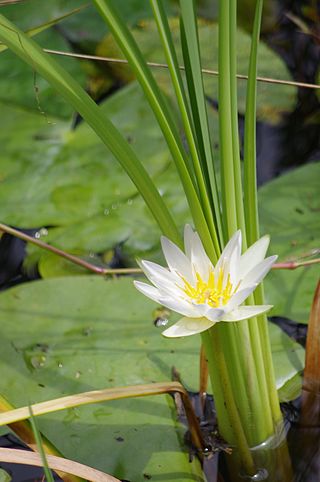
Polemonium boreale, the northern Jacob's-ladder or boreal Jacobs-ladder, is a plant native to the most of the high arctic. In Greenland it is found only in a small area on the east coast. It is not very common.

Polemonium, commonly called Jacob's ladders or Jacob's-ladders, is a genus of between 25 and 40 species of flowering plants in the family Polemoniaceae, native to cool temperate to arctic regions of the Northern Hemisphere. One species, Polemonium micranthum, also occurs in the southern Andes in South America. Many of the species grow at high altitudes, in mountainous areas. Most of the uncertainty in the number of species relates to those in Eurasia, many of which have been synonymized with Polemonium caeruleum.

The Polemoniaceae are a family of flowering plants consisting of about 27 genera with 270–400 species of annuals and perennials native to the Northern Hemisphere and South America, with the center of diversity in western North America.

Polemonium viscosum, known as sky pilot, skunkweed, sticky Jacobs-ladder, and sticky polemonium, is a flowering plant in the genus Polemonium native to western North America from southern British Columbia east to Montana and south to Arizona and New Mexico, where it grows at high altitudes on dry, rocky sites.

Polemonium acutiflorum, known as tall Jacob's-ladder, is a flowering plant in the family Polemoniaceae. It is native to western Canada and Alaska.

Rhododendron catawbiense, with common names Catawba rosebay, Catawba rhododendron, mountain rosebay, purple ivy, purple laurel, purple rhododendron, red laurel, rosebay, rosebay laurel, is a species of Rhododendron native to the eastern United States, growing mainly in the southern Appalachian Mountains from West Virginia south to northern Alabama.

Polemonium carneum is a plant native to the northwestern United States west of the crest of the Cascade Range, from Washington south through Oregon to the San Francisco Bay Area in California.

Capnoides sempervirens, the harlequin corydalis, rock harlequin, pale corydalis or pink corydalis, is an annual or biennial plant native to rocky woodland and burned or disturbed places in northern North America. Capnoides sempervirens is the only species in the genus Capnoides.

Polemonium eximium, the skypilot or showy sky pilot, is a perennial plant in the phlox family (Polemoniaceae) that grows at high altitudes. It is endemic to the Sierra Nevada in California where it grows in the talus of the high mountain slopes.

Calochortus elegans is a species of flowering plant in the lily family known by the common name elegant Mariposa lily, cat's ear, elegant cat's ears or star tulip. It is native to the western United States from northern California to Montana.

Polemonium californicum is a species of flowering plant in the phlox family known by the common names moving polemonium, low Jacob's-ladder, and California Jacob's ladder. It is native to the northwestern United States, where it grows in shady and moist habitat, such as mountain woodlands. It is a hairy, glandular rhizomatous perennial herb forming clumps of several decumbent to erect stems 30 to 50 centimeters in maximum height. The leaves are up to 20 centimeters long and are compound, made up of several pairs of oval to lance-shaped leaflets. The leaflet at the tip of the leaf is often fused to the pair behind it. The inflorescence is a crowded cluster of bell-shaped flowers each up to 1.5 centimeters wide. The flower is blue or purple with a yellow center and a whitish tubular throat. The fruit is a capsule.

Polemonium micranthum is a species of flowering plant in the phlox family known by the common names annual polemonium or annual Jacob's-ladder. It is native to western North America from British Columbia to North Dakota to California as well as disjunct in the Andes of southern Argentina and Chile. It can be found in many types of shrubby habitat, such as sagebrush scrub and foothill woodlands. It is an annual herb with a branching or unbranched stem taking a matted, spreading, or upright form. The slender stems are up to about 30 centimeters long and the herbage is coated in short, soft hairs and stalked glands. The leaves are located along the stem, each divided into several small leaflets. The solitary flowers have small white or pale blue lobed corollas tucked within cuplike calyces of hairy, pointed sepals.

Polemonium occidentale is a species of flowering plant in the phlox family known by the common names western polemonium and western Jacob's-ladder. There are two subspecies. The common ssp. occidentale is native to western North America from British Columbia to Colorado to California, where it can be found in moist areas of many habitat types, including meadows and woodlands. There is also a rare subspecies, ssp. lacustre, which is known only from a total of three counties in Minnesota and Wisconsin, and is found only in white cedar swamp habitat there.

Senecio elegans is a species of flowering plant in the aster family known by the common names redpurple ragwort, purple groundsel, wild cineraria and purple ragwort.

Ptychosperma elegans, commonly known as the solitaire palm, is a very slender palm endemic to Queensland in Australia. In the nursery trade and in the United States it may be confusingly referred to as Alexander palm, which is an often-used but misnomered name of another Australian palm species Archontophoenix alexandrae, the Alexandra palm.

Polemonium vanbruntiae is a species of flowering plant in the phlox family Polemoniaceae. It is known by the common names Appalachian Jacob's ladder, bog Jacob's-ladder, and Vanbrunt's polemonium. It is native to eastern Canada and the northeastern United States.
Askellia elegans, the elegant hawksbeard, is a species of North American plants in the tribe Cichorieae within the family Asteraceae. It is native to central and western Canada and the northwestern United States.

Polemonium foliosissimum, the towering Jacob's-ladder, is a rare species of flowering plant in the phlox family Polemoniaceae, native to the western United States; Arizona, Colorado, Idaho, Nevada, New Mexico, Utah and Wyoming. As its synonym Polemonium archibaldiae it has gained the Royal Horticultural Society's Award of Garden Merit.

Polemonium pauciflorum, the fewflower Jacob's-ladder, is a rare species of flowering plant in the phlox family found in the United States and Mexico.

Nymphaea elegans, also known as the tropical royalblue waterlily, is a species of aquatic plants in the family Nymphaeaceae. It is native to the United States, Mexico, and the Bahamas. It has been introduced to Colombia. Additionally, it has been reported to occur in Argentina.



















